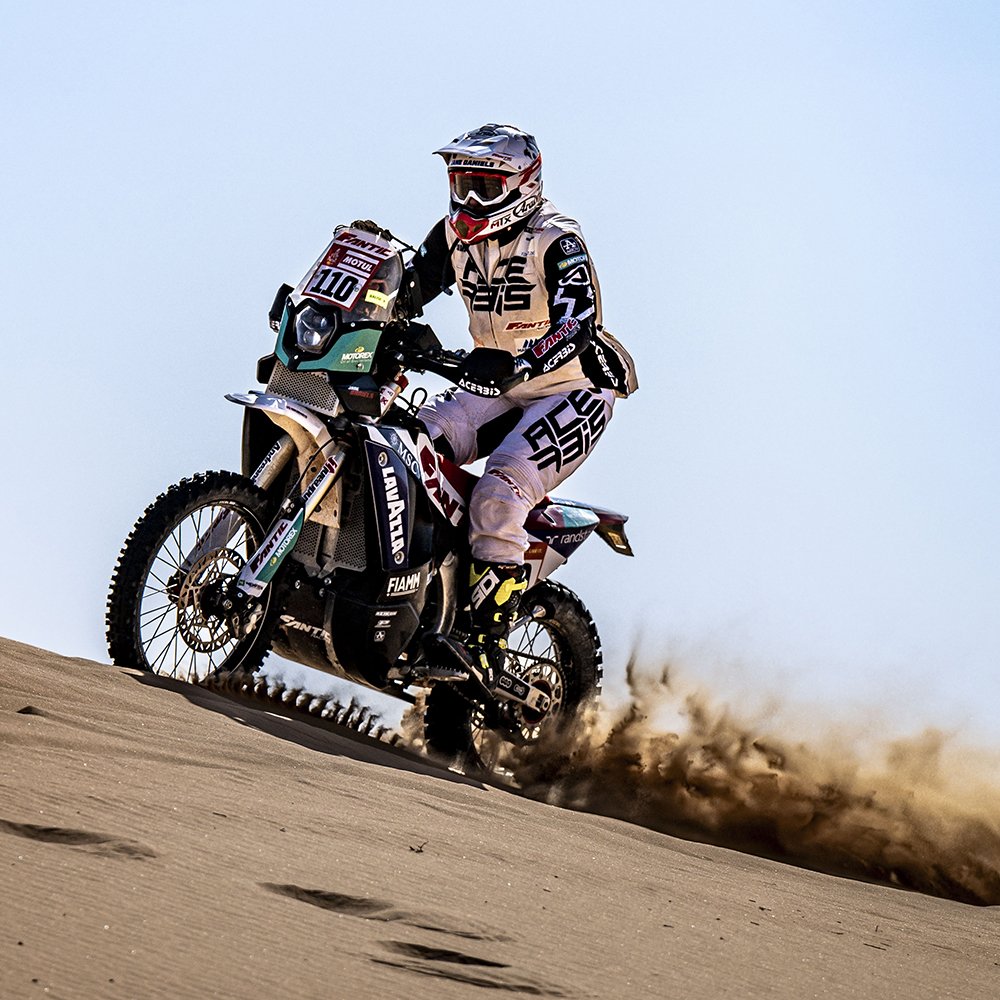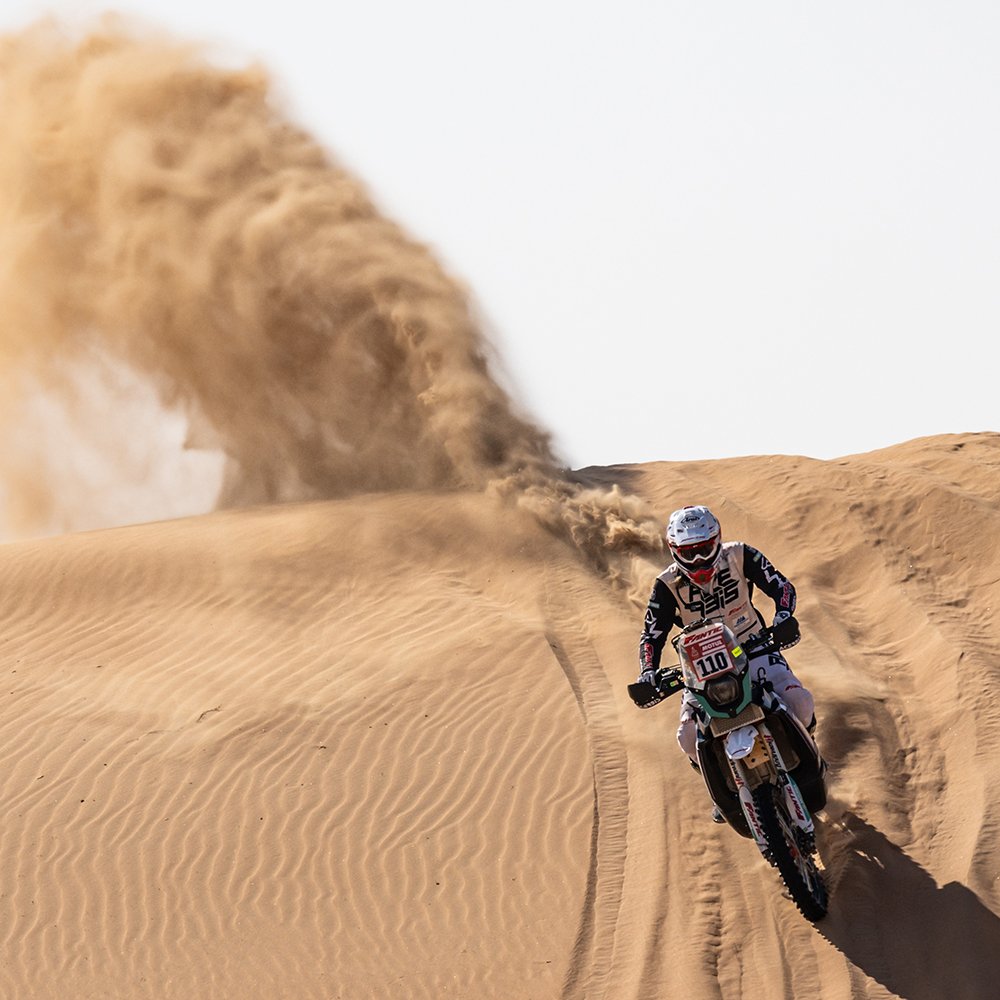QUEEN OF THE DESERT
Jane Daniels has been at the core of Women’s World Enduro Championship for over a decade, winning the title in 2019, 2020, ’22 and ’23. She was also part of the International Six Days (ISDE) winning team in 2022.
We caught up with the 30-year-old Kriega supported athlete, at her home in Wigan, Northern England, to discuss her career, her successful debut at the 2024 Dakar, where she won the women’s class at her first attempt, and her plans for the future.
KRIEGA: What was your first motorcycle and the first time you ever competed on a motorcycle?
Jane: My first motorcycle was a Honda QR 50, I think I was around seven, I used to ride it at my grandma's house in her garden and up the fields behind her house. At this age my brother, Gary, and I didn't really know about racing, riding was just something we did for fun on a free weekend when our dad wasn't racing, or in summer when it was warm. We would ride there in the evenings, when we went for tea on a Wednesday.
My first race was on a Yamaha TT-R125 in 2006. I absolutely loved it and I remember I only fell off once which I was really glad about because I did struggle to pick that bike up back then, it felt so heavy.
When did motorcycle racing become a career?
It depends what you class as a career, but racing became my full-time job in February 2023, and I did the whole of last season with racing being my main focus, which was incredible. But I first raced a World Enduro event in 2012. I raced the third round of the Women’s Enduro World Championship, finishing second on the first day. Unfortunately, I wasn't able to start the second day as I had made myself ill riding in 42˚C heat and only drinking water. In fact, I overhydrated and diluted my system so much that I was quite sick and had to sit out the second day, after receiving some hospital treatment before the podium at the end of the first day’s racing.
From there I raced every round of the Women’s World Enduro Championship right until the end of 2023. During 2012 I did some other international extreme races, because my brother was doing them and the van was going anyway, so I jumped in and we raced Extreme Lagares [Portugal], Hard Enduro Piatra Neamt [Romania] and Erzberg [Austria] that year.
Do you have a ‘day job’ or are you 100% concentrating on motorcycling?
Before turning pro last February, I have always worked. I was a delivery driver for my dad from leaving school up until Covid happened and then I've had some part-time jobs in between that time and February 2023.
How has women’s off-road racing changed in the time you’ve been competing?
In all honesty it hasn't changed much, I have been pushing for the promoters of the World Enduro Championship [aka Enduro GP, EGP] to support the women's class and introduce a manufacturer’s trophy so that there is more incentive [for them] to support women like the men's classes. This hasn't changed from when I started EGPs, but it was really nice to see they have finally introduced the winner’s bike also placed in front of the podium women's podium like the men's class have had for many years. I'm really hoping this is a small step in the right direction to encourage the manufacturers to help the women as we are just as capable as the men, and we do get the results and the social media coverage that they are looking for.
You made your Dakar Rally debut in January, how did the chance to race the Dakar come about?
Dakar came about through an interview I had for an Italian magazine with a journalist called Dario Agrati. He asked me if I ever considered it and my answer was it’s something I would love to do, but it’s not something that my dad and I could ever do from the back of our van, like we have the World Enduro Championship. Fantic saw this article and were pleasantly surprised I think. When I flew over there to discuss my 2023 contract with Fantic, it was mentioned so I knew they had seen the article. Upon further discussion they offered me the chance to go to Dakar in 2024, providing that I qualified at one of the W2RC [World Rally-Raid Championship] races within the season, which was Rally Du Maroc. I flew to the Maroc rally directly from the final world round last year and I had to finish to prove that I was worthy of a position in the Dakar 2024 entry list.
Was the Dakar something that had been on your bucket list, or not?
It was 100% something on my bucket list, but it wasn't something I thought too much into as I was very much focussed on the World Enduro Championship every year. When the opportunity was there to go with the Fantic Factory Racing Team, and they would fully support me throughout the Dakar, and with preparations for it, it was an opportunity I couldn’t miss.
How long did it take you to make the decision, and what were the considerations?
If I'm honest, it didn't take me long to decide. When Fantic presented me with this opportunity, it’s certainly not something that will come around twice in a lifetime, so I couldn't say no. I had won the World Enduro Championship [EGP] in 2022, and wasn't sure if just racing for the EGP again in 2023 was enough, this was the deciding factor as to whether I would race in 2023 at all. I was happy to walk away from racing after winning three World Championships and still working alongside racing. It was tiring but I felt like I had achieved what I had set out to after ten seasons there. But with the opportunity of racing Dakar I was more than happy to make my hobby my dream job, race for another world enduro title, and then the cherry on top (all being well), race the Dakar at the beginning of 2024.
How did you modify your training to be ready for it?
The enduro season is very long so I didn't really get to modify my training for Dakar. I raced all year in enduros [Jane won the 2023 Women’s World Enduro Championship]. I raced nearly every weekend and on Wednesdays I went practising, along with gym work, cycling and preparing the bike each week. On the very rare occasion we had no race, we drove out to Italy for two weeks and I did a week of enduro training and then a week of rally training. I managed race a fun rally in Tunisia in May, which was five days of learning how to read a road book and ride a 450 rally bike. I stayed in Italy for another week to do some more road book training and take part in the Italian Motor Rally race which was two days.
So, all in all, I rode the rally bike for ten days before I started the Rally Du Maroc race. After that, it was so close to Christmas and I didn’t have a rally bike at home, so I rode rally for three more days between Morocco and Dakar itself, I was just training enduro all the time in between.
What were the surprises about the event?
I was surprised at the sheer size of the paddock at Dakar. It’s crazy how many competitors and assistance people and vehicles there are! The paddock never sleeps and there is always someone testing a vehicle somewhere and there is a constant buzz of generators and power tools working. The canteen was huge and must have seated 250-plus people at a time which was crazy.
I did not expect to be on my bike for 10-13 hours all day every day for 14 days. That was truly a test of my strength and resilience! I couldn’t believe the distances we were covering each day and a lot of that was in special stages, so we were being timed and trying to race for that long is really tiring, and I was getting hungry and losing concentration. It was like nothing I’d experienced before.
What was the highlight?
Finishing! After such a long and gruelling two weeks, the finish line was my main goal and I made it there, so I was super happy about that. I also loved that my dad and boyfriend were able to come for the final three days of the race. To share a part of the experience with them was really lovely.
And the lowest moment?
When I crashed at the beginning of the 48-hour stage. I couldn't get the bike back straight and I wanted to be able to give my best throughout the whole race so this definitely hindered me a little bit. But I learned to ride with the bike a little bit twisted as there wasn't a lot I could do about it until I reached my mechanic on the rest day.
How different did the rally bike feel from your regular race bike, and how did you have to change what you did?
The set up on each bike is completely different. With the enduro bike its quite a small and compact feel to it, so that you can throw it around in the tight special tests and really attack everything that you're racing. Where the rally bike has a lot more of a stretched out and relaxed riding stance, as you are on the bike for so long it would be nearly impossible to ride an enduro bike like set up for this many hours a day, my back would be in pieces! On the rally bike you have bigger foot pegs than on the enduro bike, for comfort on the long stages, also you have foam grips to reduce the vibrations. The handlebars are mounted a lot taller to allow room for a steering damper which is essential to stop headshake at the high speeds. We carry a lot more fuel on the rally bike because of the distances we cover, which then reflects on the suspension, and we have a lot heavier springs and valving to accommodate the extra weight.
Final question, what are your plans for 2024?
My plans for 2024 are to remain very much involved in the off-road motorcycling industry while also expecting our first child in late-October. I love racing and motorbikes and I will continue to work alongside Fantic as their Brand Ambassador throughout my pregnancy, while also giving back to the sport I love and have been heavily involved in throughout the last 17 years.
We have supported Jane over the last 10 years with her race hydration needs, her favourite pack being the Kriega Hydro-3
Photos: Fantic Racing / Kriega
Follow Jane www.instagram.com/janedaniels196/






